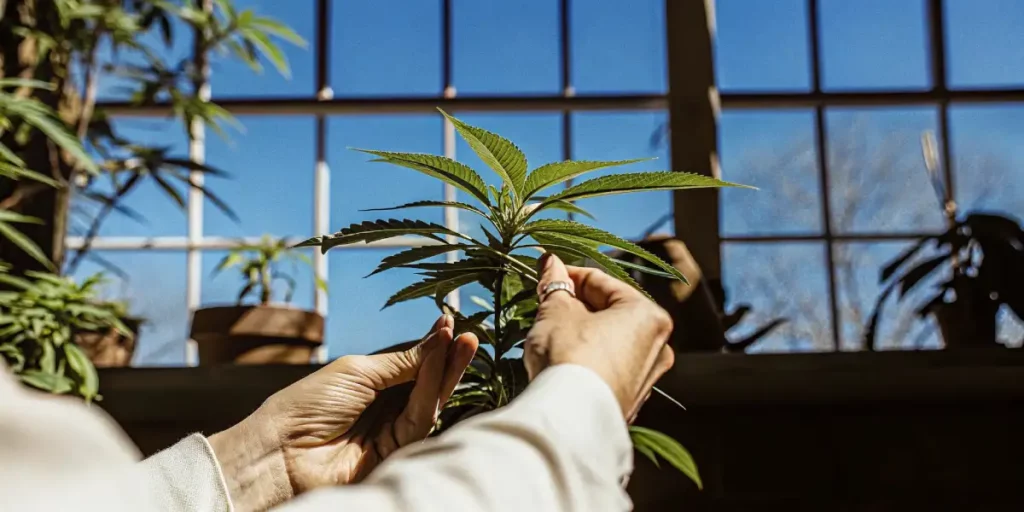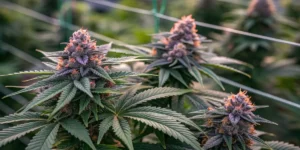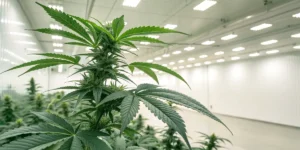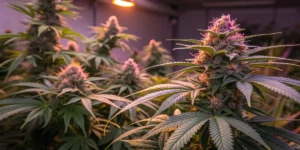Defoliating autoflowers can significantly impact their growth and yield. This technique involves removing some of the plant’s leaves to allow light to reach lower parts of the plant. For first-time growers, this might seem daunting, but learning when to defoliate autoflowers and how to do it properly becomes second nature with a little practice.
Timing plays a crucial role. You don’t want to stress your plants by defoliating at the wrong time. The best time to defoliate autoflowering cannabis is during the vegetative stage. At this stage, plants are robust enough to recover quickly.
As you gain experience, you’ll notice how your plants react to defoliation. Some strains like Northern Lights from Global Green Genetics can handle more aggressive defoliation, while others might require a gentler touch.
How and when to defoliate autoflowers for healthy growth
When to defoliate autoflowers depends on the plant’s stage, but once you’re ready, start by identifying the leaves that are blocking light. These are usually the larger fan leaves at the top of the plant. Gently remove them with a sharp pair of scissors or pruning shears. This allows more light to penetrate the canopy, reaching the lower buds.
Be cautious. Removing too many leaves at once can shock the plant. A good rule of thumb is to remove only 20-30% of the foliage at a time. This ensures the plant can still photosynthesize effectively.
When learning how to defoliate autoflower plants, it’s crucial to maintain a steady hand and a careful eye. Observing the plant’s overall health and growth pattern will guide you in making the right cuts. If you notice any negative reaction, such as wilting or discoloration, it may be a signal to ease back on defoliation.
It’s also important to sterilize your tools before making any cuts. This practice helps prevent infections and diseases that could harm the plant. By ensuring your tools are clean, you promote a healthier environment for your autoflowers to thrive.
Defoliation Techniques for Autoflowers
Cannabis growers use several techniques when it comes to defoliation. The most common method is to gradually remove leaves over a few days. This minimizes stress and allows the plant to adjust.
Another technique is called “lollipopping.” This involves trimming the lower third of the plant. By doing this, you encourage the plant to focus its energy on the upper buds, which often results in larger yields.
Knowing defoliation techniques for autoflowers is key to maximizing your harvest. Each technique offers different benefits and can be tailored to fit the specific needs of your plants. Experimentation is encouraged, as it helps in discovering the most effective method for your particular strain.
When to defoliate autoflowers also plays into the technique chosen. A gradual approach might suit some strains better, while others may benefit from more aggressive methods like lollipopping. Monitoring plant response is critical to determining the best strategy for your grow operation.
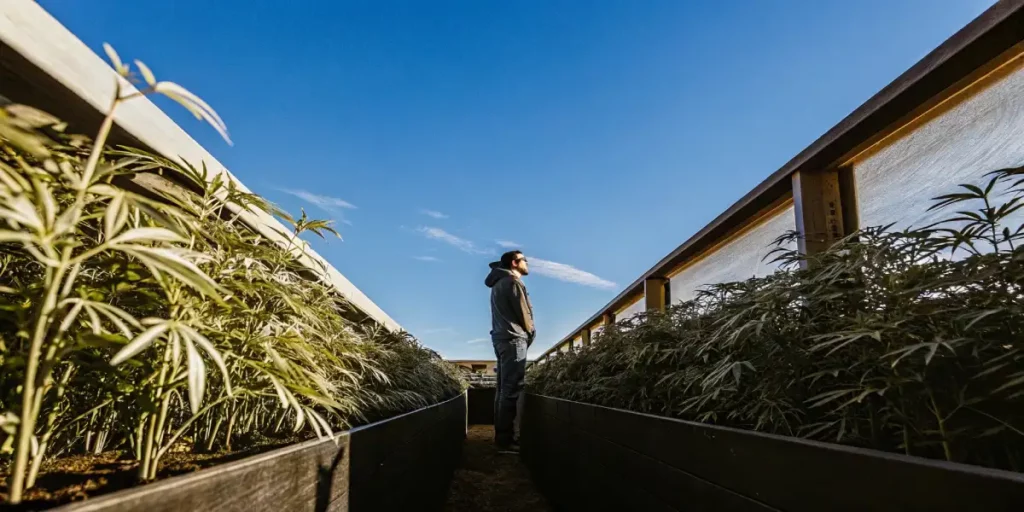
Timing for Defoliating Autoflower Cannabis
Timing is everything when it comes to defoliation. For autoflowers, timing can be a bit tricky since they have a shorter life cycle. Start defoliating in the third week of the vegetative stage. This is when the plant is at its strongest.
Avoid defoliating during the flowering stage. Autoflowers transition to flowering based on age, not light cycles. Removing leaves during this period can reduce yield. Strains like Gorilla Glue 4 from Global Green Genetics are more resilient, but it’s still best to err on the side of caution.
When considering the timing for defoliating autoflower cannabis, remember that early mistakes can often lead to learning opportunities. Tracking your plant’s progression through each stage will help you refine your timing in future grows. This hands-on experience is invaluable for knowing the best time to defoliate autoflowering cannabis.
It’s also beneficial to note environmental factors that might influence the timing. For instance, plants growing in outdoor conditions may respond differently to defoliation compared to those in controlled indoor settings. Adjusting your timing based on these external conditions can improve results.
When to Defoliate Autoflowers and Its Impact on Yield
Done correctly, defoliation can boost yields by improving light penetration and airflow. This helps to prevent mold and mildew, which can be a problem in dense foliage. More light and air mean healthier plants and bigger buds.
However, defoliation isn’t without risks. Removing too many leaves can stunt growth. It’s important to observe how your plants react and adjust your technique accordingly. Each strain has its own response to defoliation, so keep a close eye on your plants.
The impact of defoliation on autoflower yield is a balancing act between enhancing growth and avoiding stress. By carefully monitoring the plant’s response, growers can optimize the conditions for maximum yield. This requires patience and an attentive approach, but the rewards are often substantial.
Knowing when to defoliate autoflowers is integral to achieving a successful harvest. The goal is to enhance the plant’s natural ability to produce large, potent buds. With practice, you’ll develop a keen sense for the appropriate amount of defoliation needed, contributing to a thriving garden.
- Remove only 20-30% of leaves at a time to prevent shock.
- Focus on large fan leaves that block light to lower buds.
- Begin defoliation in the third week of the vegetative stage.
- Avoid defoliating during the flowering stage of autoflowers.
- Experiment with different techniques to find what works best for your strain.
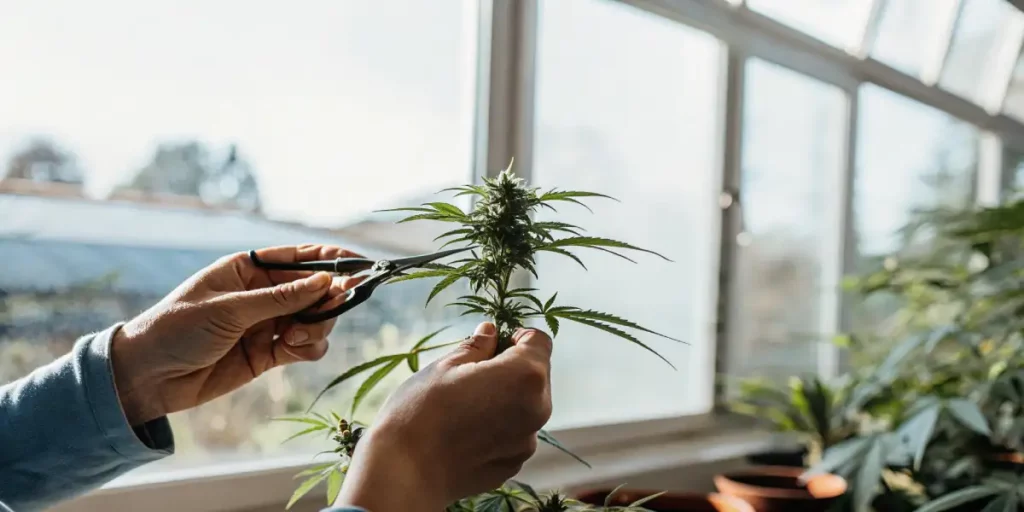
FAQs of when to defoliate autoflowers
What is the best time to defoliate autoflowering cannabis?
The ideal time is during the vegetative stage. Specifically, the third week is when the plant is mature enough to handle defoliation without experiencing too much stress. This timing allows for optimal light penetration and airflow, which are crucial for healthy growth.
During this period, plants like Northern Lights from Global Green Genetics are in a vigorous growth phase. Removing large fan leaves that block light to lower buds helps maximize the plant’s potential. Always monitor how your plant responds to defoliation, as each strain might react differently.
Knowing the best time to defoliate autoflowering cannabis is essential for maximizing growth. By aligning defoliation with the plant’s natural life cycle, you encourage a robust and productive growth phase. This ensures that your plants are well-positioned to transition smoothly into the flowering stage.
Consider documenting your defoliation schedule and its impact on your plants. Over time, this will help you develop an intuitive sense of when to defoliate autoflowers for optimal results. Such records can be invaluable for both novice and experienced growers alike.
How does defoliation impact autoflower yield?
Proper defoliation can increase yields by improving light exposure and air circulation. This helps the plant focus its energy on developing buds rather than maintaining excess foliage. The result is often denser, larger buds with better overall quality.
However, excessive defoliation can have the opposite effect. If too many leaves are removed, the plant might not be able to photosynthesize effectively, leading to reduced growth and smaller yields. It’s crucial to strike a balance to achieve the best results.
Defoliation, when executed skillfully, can transform the yield potential of autoflowering plants. By enhancing light exposure, the plant can channel more energy into bud production rather than maintaining unnecessary foliage. This strategic focus often results in a more bountiful harvest.
On the flip side, knowing the risks of defoliation is just as important. The impact of defoliation on autoflower yield can be negative if the plant is stressed. Therefore, careful observation and incremental changes are key to realizing the full benefits without compromising plant health.
When to defoliate autoflowers: can they handle it during flowering?
It’s generally advised against defoliating during the flowering stage. Autoflowers are especially vulnerable during this time because they flower based on age. Removing leaves during flowering can stress the plant and reduce yields.
Some strains, like Gorilla Glue 4 from Global Green Genetics, may tolerate light defoliation during flowering, but it’s not recommended. The risks usually outweigh the benefits, so it’s best to focus defoliation efforts on the vegetative stage.
While some growers may experiment with minimal defoliation during flowering, knowing the specific strain’s resilience is crucial. When to defoliate autoflowers must be carefully considered, as the flowering stage is critical for bud development and can be adversely affected by stress.
For those unsure of their plant’s capacity to handle defoliation during flowering, it’s safer to refrain and allow the plant to focus on bud growth. This cautious approach ensures that the plant’s energy is directed towards producing the best possible yield.
How do I know if I’m defoliating correctly?
Look for signs of healthy growth after defoliation. The plant should continue to grow vigorously, with no signs of wilting or yellowing leaves. If the plant appears stressed or stops growing, you may have removed too many leaves.
Experiment with small changes and monitor the results. Keeping a journal of your defoliation practices and the plant’s responses can help refine your technique over time. Every strain and growing environment is different, so there’s always a learning curve.
Indicators of successful defoliation include a healthy, vibrant plant with a robust growth rate post-defoliation. If your plant is thriving, it’s a good sign that you’re applying the right techniques. Adjustments can be made based on the plant’s feedback, allowing for continuous improvement.
Consider engaging with grower communities or forums to learn from others’ experiences with defoliation. Sharing insights and techniques can provide valuable perspectives, helping you enhance your own defoliation practices for better results.
What strains respond best and when to defoliate autoflowers for optimal results?
Some strains naturally respond better to defoliation than others. For instance, Blue Dream from Global Green Genetics is known for its robust growth and ability to handle various defoliation techniques. It tends to produce large, flavorful buds when properly defoliated.
On the other hand, more delicate strains may require a gentler approach. Always consider the specific needs and characteristics of the strain you’re growing. Over time, you’ll develop an intuition for which plants can handle more aggressive defoliation.
Researching strain characteristics can greatly aid in knowing which plants will thrive under defoliation practices. Some strains have a natural robustness that makes them more forgiving of more aggressive techniques, while others may show better results with minimal intervention.
Evaluating the response of different strains to defoliation is part of the learning process. Keeping detailed records of strain performance can guide future grows, helping you determine when to defoliate autoflowers for each specific variety to maximize their potential.

